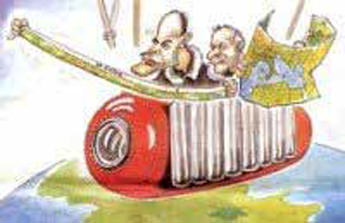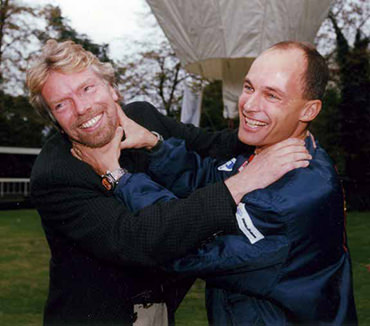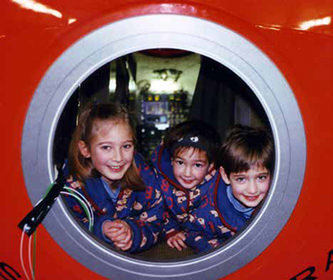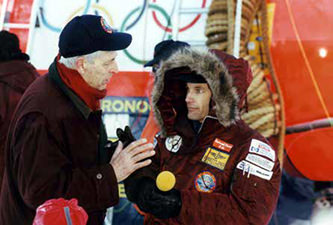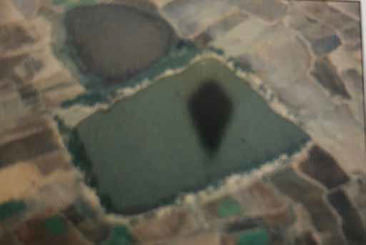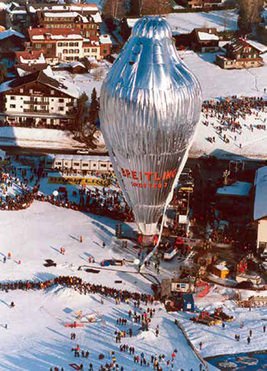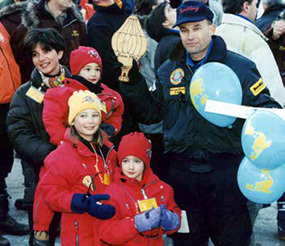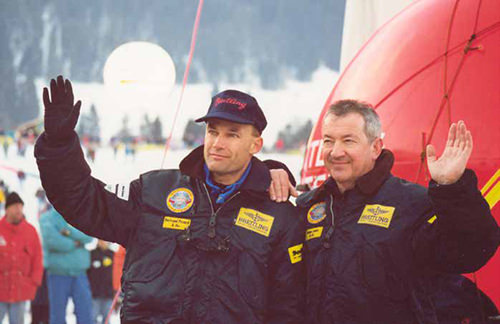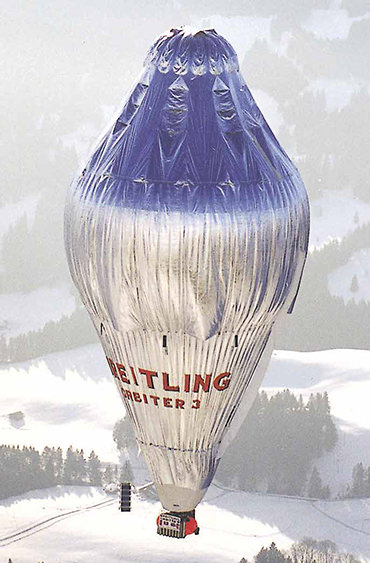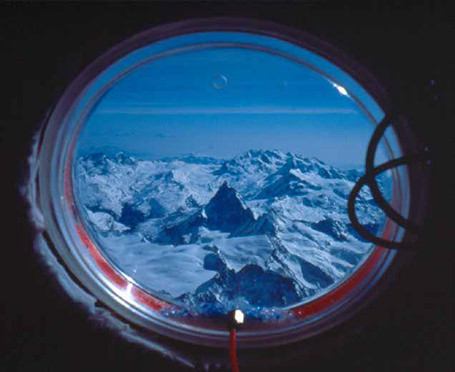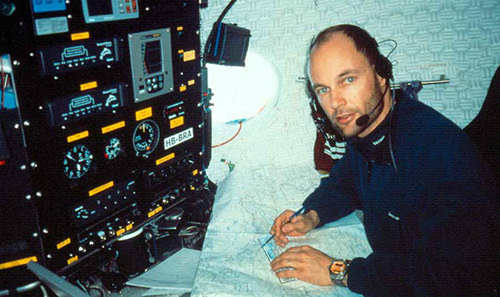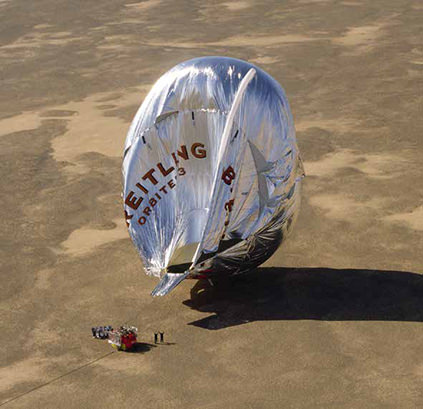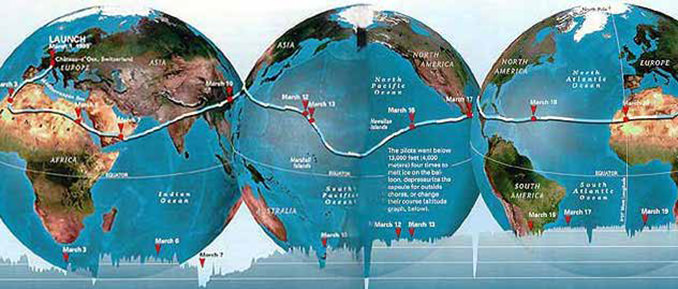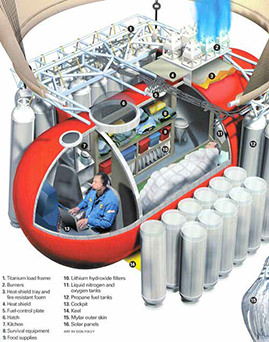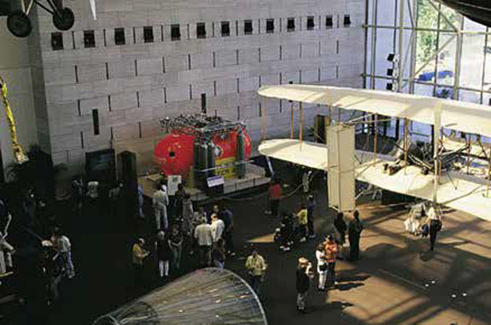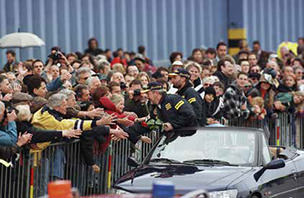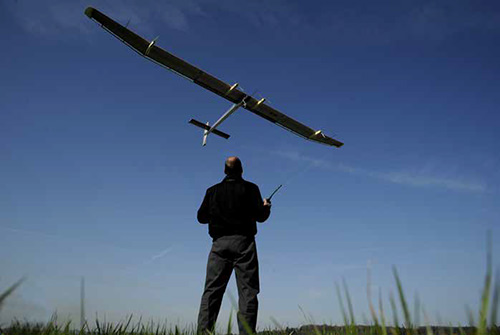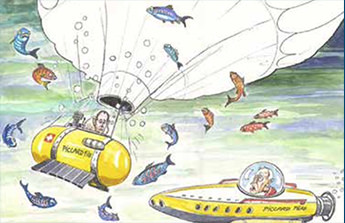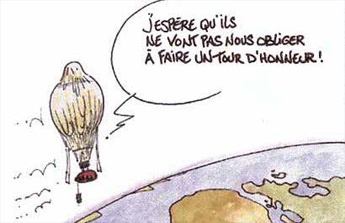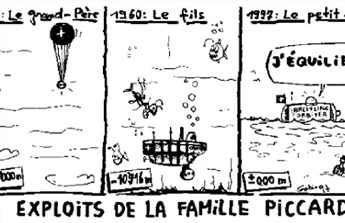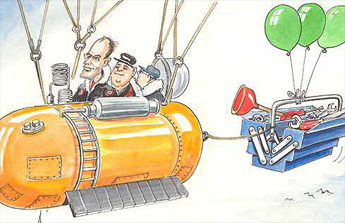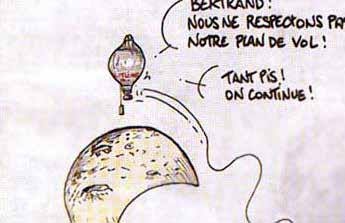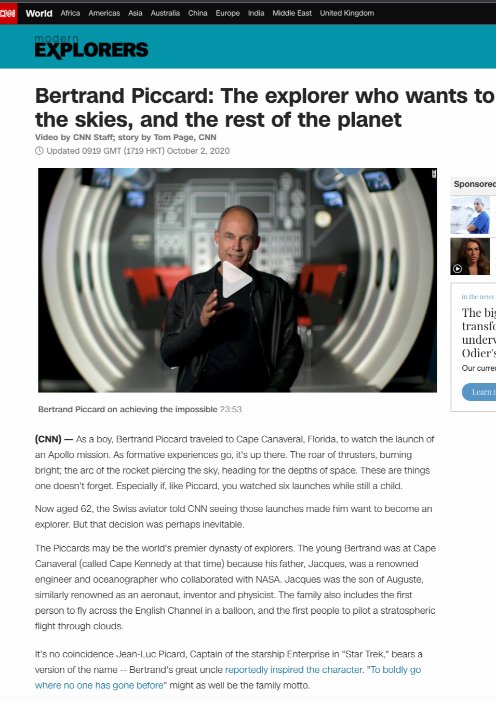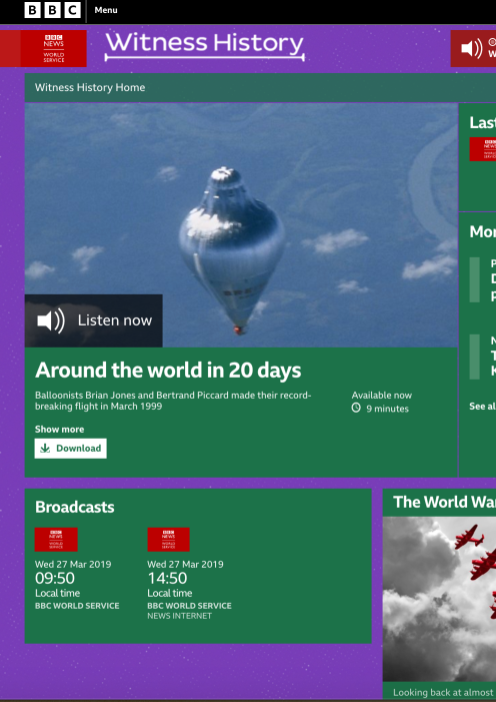
The ultimate feat in aviation: achieving the first non-stop around-the-world balloon flight
At first everyone thought it an impossible dream: flying all around the Earth without an engine or any way of steering, just being pushed along by the wind. For the media, it was the last great adventure of the century. Several billionaires such as Richard Branson and Steve Fossett had made unsuccessful attempts, as had Bertrand Piccard – twice - before he won the prize in March 1999, with Englishman Brian Jones. This epic voyage fascinated the public on several counts: as a metaphor – an impossible dream achieved through perseverance; as a human adventure - a new page in aviation history; for the cutting-edge technology; and not least for the sporting achievement, with 7 world records to boot.
The Poles, continents, mountain summits, space and the ocean abysses had all been explored, but although the balloon had been invented in 1783, none had yet circled the earth! When Bertrand started mounting the Breitling Orbiter project, the longest-ever balloon flight in history was only 6 days long. To fly around the world, you had to design and build a new type of device with an endurance of 3 weeks – half gas-balloon, half hot-air balloon – and then allow yourself to be pushed along by the winds, searching for the right airflows to control your direction of travel. Jules Verne just imagined it. Bertrand and Brian actually did it!
« I wanted to find new ideas blowing in the wind that would enable me to function still better on Earth in my roles as a doctor and a human being. »
From 1992
-
After winning the Transatlantic Balloon Race, Bertrand dreamed of embarking on a project then considered impossible: to fly around the Earth carried by the wind, without any engine or way of steering.
-
A real international competition
A coveted challenge – to write a fresh page in history
This dream, first imagined by Jules Verne, attracted many balloonists from 1981 onwards, and in the early 90s a real race developed. The FAI (International Aeronautical Federation) laid down the rules.
Over several years, many competitors made in-depth preparations, but had to face bitter failures. To mention only those who succeeded at least in getting off the ground, there were: Max Anderson with his Jules Verne balloon; Larry Newman’s Earthwind; Richard Branson’s Virgin Global Challenger; Bertrand Piccard’s Breitling Orbiter; Steve Fossett’s Solo Spirit; Kevin Uliassi’s J-Renée; Dick Rutan’s Global Hilton; and Andy Elson’s Cable and Wireless. If it had been easy, all these would have already done it!
-
1997
1st Attempt:
Breitling Orbiter 1On 12 January 1997, Bertrand announced a flight lasting 15 days, using the jet streams. But after only 6 hours of flight, his capsule ended up floating miserably in the Mediterranean! A massive fuel leak had forced him and his teammate, Wim Verstraeten, to make an emergency ditching due to the risk of an explosion.
-
« We had set off for what the media had billed the “last great planetary adventure”, in one of the most beautiful balloons ever built …and we barely managed to cover 500 kilometers… We had disappointed so many people. It was the biggest failure of my life… One way, so to speak, of being vaccinated for ever against ridicule! And of discovering that the pioneering spirit does not automatically guarantee great success. »
-
1998
2nd Attempt:
Breitling Orbiter 2.After nine days in flight, another disillusionment, despite setting an absolute world duration record. Breiting Orbiter 2 managed this time to reach Asia. However, faced with the Chinese authorities refusing to grant overflight permission for their territory, Bertrand and his two teammates, Andy Elson and Wim Verstraeten, had no option but to land in the Burmese countryside.
-
« There is only one way of never failing ... and that's never to try and achieve anything. But to be successful, we had to move our project up to a new altitude, and subject our plans and strategies to rigorous, concrete reassessment. There was no question of setting off once again with the idea of flying fast in the jet streams, because that did not give us the maneuverability needed to avoid obstacles - whether political, geographical or meteorological. We therefore needed a different kind of balloon, capable of exploiting all the atmospheric layers without consuming more gas. In particular, it had to be capable of loitering at low altitude until upper-level airstreams started flowing in better directions. We opted for propane, rather than kerosene burners, and a new envelope with much better thermal insulation. »
March 1999
The winning flight around the world
Breitling Orbiter 3 , The longest flight in the history of aviation, both in duration and distance
-
« A balloon lifts off into the frozen winter sky, rises silently above the mountain-tops… and then disappears. We were all like children, spellbound, as we watched Piccard and his companion soar aloft, in search of the right winds, on their mission to circumnavigate the globe. As simple as Icarus's dream. Like something out of Jules Verne. An elegant, volatile scrap of fabric, woven from madness, stuck onto our gravity-bound rags. »
Pascal Décaillet, Radio Suisse Romande -
Respecting the Chinese overflight restrictions
The first problem was to fly south to below the 26th parallel to respect the Chinese restrictions. For the two meteorological wizards, Luc Trullemans and Pierre Eckert, that meant trying to thread a needle 15,000 kilometers distant! But they succeeded!
-
Opening up the route, and the borders
A trip around the world is also a tour of countries, officialdom, and regional policies. Swiss air traffic controllers and diplomats were constantly called upon to pave the way through Egypt, Yemen, India, China and Japan.
-
Finding the best trajectory
Eleven days to reach the Pacific, concentrating 100% on maintaining the optimum altitudes calculated by the meteorologists to the nearest meter, sometimes cruising along in jet streams, but often in much lighter winds, playing around with areas of low pressure over the Mediterranean and high pressure over India. The strategic choices were often painfully hard. Was it better to fly north in strong winds, or further south in lighter winds?
-
Crossing the Pacific
As the Pacific came close, deciding which route to take was especially tough: the southern route added 4,000 kilometers to the trip! Yet that was the option recommended by the meteorologists, with storms raging in the North.
With winds of 30 km / hour, surrounded by storm clouds and cut off from the control center because of satellite antenna problems, Bertrand and Brian had to watch helplessly as their chances of success and their propane reserves dwindled. But after they had spent six agonizing days over this immense ocean, the meteorologists' bet paid off. The balloon finally entered a powerful jet stream that carried it towards Mexico at 180 km/hour.
-
« What could be more marvelous, more precarious, more sophisticated than to cross the mighty ocean borne along only by the wind? This is a marriage of poetry and technology ... Following in the footsteps of his grandfather and father, Bertrand Piccard has added a splendid and moving new page to his great family saga. » (Nicolas Hulot)
-
Finding another jet stream
And yet the speed dropped right off again, as the jet stream ejected the pilots off towards Venezuela. Something similar had happened to Richard Branson a few months earlier, forcing him to ditch south of Hawaii. In desperation, searching for better winds as they approached the Caribbean, Bertrand tried one last poker play: using a huge amount of propane to climb as high as possible. High up there at 10,500 meters, the airflow miraculously sent them back in the right direction!
-
Atlantic crossing
There were still 10,000 kilometers left to run - a quarter of the total trip. But they were down to the last eighth of their gas supply. The only way they could succeed was if the wind speed quadrupled… and that is precisely what happened!
-
Landing in Egypt
On 20 March, Bertrand and Brian crossed the final meridian on their dream flight at 200km/ h. The next day, they landed in Egypt - and in the history books, with the longest flight in aviation history, both in distance and duration. But more important than their 7 world records was that they had returned with a feeling of having forged a new, more intimate and more respectful relationship with the planet. During this 20-day flight, the time of an Olympic truce, the Breitling Orbiter had become a bridge linking all the countries in the world by delivering a message of peace to their governments, with the IOC
Discover the day-to-day BO3 Logbook by Bertrand Piccard
Read the Logbook« Piccard's adventure was not technical in nature. Or rather, not only that. It was first and foremost, a spiritual affair. Piccard is not a Passepartout, nor even a Phileas Fogg. He is more like Saint-Exupéry flying over the desert. His view of the world is that of St-Exupéry’s Little Prince.
Starting from there, he might succeed, or he might not. I’d almost say it’s a side-issue. Unlike us earthbound mortals, he will at least have gone to have a look. We would like to salute Piccard. He’s like Chang’s scarf, standing out among the Tibetan rocks, persuading Tintin to embark on his quest for the absolute. Not for the adventure in itself, but for the brotherhood of men. »
Radio Suisse Romande
-
Lift-off on 1st March 1999 at Château-d'Oex (Swiss Alps) Countries overflown Switzerland, Italy, France, Monaco, Spain, Morocco, Mauritania, Mali, Algeria, Libya, Egypt, Sudan, Saudi Arabia, Yemen, Oman, India, Bangladesh, Myanmar, People's Republic of China, Taiwan, Japan, Mexico, Guatemala, Belize, Honduras, Jamaica, Haiti, Dominican Republic, Puerto Rico, Mauritania, Mali, Algeria, Libya, Egypt. Landing on 21 March 1999 at Dakhla ( Egypte) Total distance 45'633,791 km Total flight time 19 days, 21 hours, 47 minutes (477 h 47), an absolute world record Maximum altitude reached 11,737 meters, a world record for the category
-
1999-2000
Exploit receives universal recognition
The Breitling Orbiter 3 took its place in the main hall of the prestigious Smithsonian Air and Space Museum in Washington, next to the Apollo 11 capsule and the legendary aircraft of the Wright Brothers, Charles Lindbergh and Chuck Yeager.
The pilots were given festive welcomes around the world, and were honored by several monarchs and heads of state. Bertrand received the Legion of Honor, the Olympic Order, and the French Youth and Sport and Aeronautics Medals, as well as the highest distinctions of the Fédération Aéronautique Internationale, the National Geographic Society, the Explorers Club , the American Academy of Achievement, and numerous other aeronautical, scientific and sports associations.
-
Using their fame to serve a cause
The two pilots, with their partner Breitling, delivered on the promise they had made on landing: to dedicate their triumph to the children of the world and to fight neglected suffering. They created the "Winds of Hope" Foundation, and used their celebrity to become engaged in the fight against Noma, a disease that harrowingly mutilates the faces of hundreds of thousands of children in the poorest regions of Africa and Asia.

-
A crazy idea
After this exploit, Bertrand started thinking bigger still. During his 20-day balloon flight, he very nearly ran out of the fuel needed for success. So, Bertrand conceived of a new way of flying around the world - in a solar airplane, with no fuel or polluting emissions. This vision of promise gave birth to Solar Impulse, a symbol of his desire to promote the pioneering spirit in the field of renewable energies and clean technologies.
Considered the final great adventure of the 20th century, the around-the-world balloon flight had revealed the need for a new alliance between man, technology and nature, for progress based on clean energies: respecting nature, and making her your ally.
Breitling Orbiter 1
12 January 1997 : forced ditching in the Mediterranean after a flight lasting 6 hours, caused by a fuel leak in the cabin.

Breitling Orbiter 2
28 January to 7 February 1998 : absolute, all-categories, world record for duration. Landing in Myanmar because of ban on overflying China.

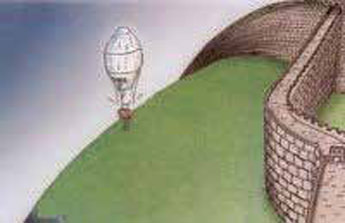
Breitling Orbiter 3
1st to 21 March 1999: First non-stop around-the-world flight in a balloon; the longest flight ever in aviation history, both in distance and duration.
